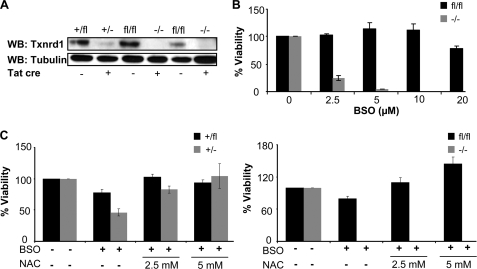FIGURE 4.
GSH depletion-mediated cell death of Txnrd1−/− cells cannot be prevented by NAC supplementation. A, loss of Txnrd1 in Txnrd1−/− cells after Tat-Cre treatment was confirmed by Western blot (WB). B, Txnrd1fl/fl and Txnrd1−/− cells were treated with the indicated BSO concentrations for 72 h, and cell viability was determined by trypan blue exclusion. Txnrd1−/− cells were highly susceptible to BSO as compared with the parental cell line (4.14 ± 0.46% versus 113.56 ± 12.41% viability at 5 μm BSO) (means ± S.D.). The data shown here are representative of two independent sets of experiments and were confirmed with another knock-out cell line (data not shown). The heterozygous control cell line behaved in a similar manner as the respective parental cell line (data not shown). C, the thiol-containing antioxidant NAC (2.5 and 5 mm) failed to rescue Txnrd1−/− cells from cell death induced by BSO-mediated GSH depletion (10 μm BSO; right panel), whereas NAC provided resistance against BSO in wild-type (Txnrd1fl/fl and Txnrd1+/fl) and heterozygous (Txnrd1+/−) cell lines (left panel). Txnrd1+/− cells behaved similarly to Txnrd1+/fl cells, i.e. both cell lines could be efficiently rescued by NAC. The data are representative of two sets of experiments and were confirmed with another Txnrd1−/− cell line (data not shown).

